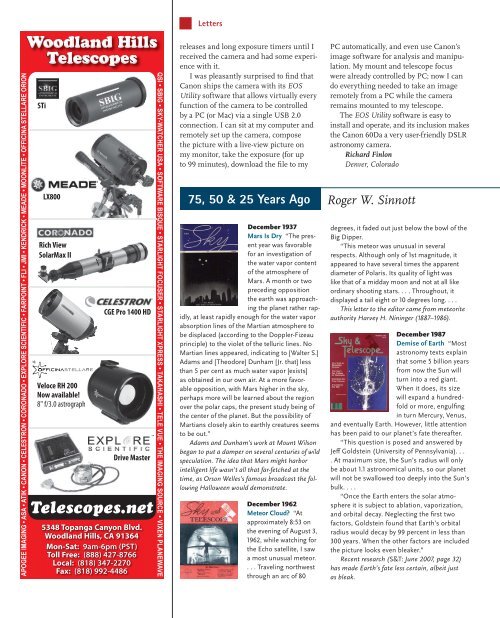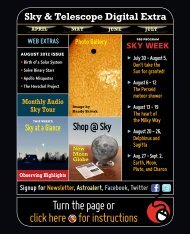Sky & Telescope Magazine December 2012 - TuLaTri.com
Sky & Telescope Magazine December 2012 - TuLaTri.com
Sky & Telescope Magazine December 2012 - TuLaTri.com
Create successful ePaper yourself
Turn your PDF publications into a flip-book with our unique Google optimized e-Paper software.
APOGEE IMAGING • ASA • ATIK • CANON • CELESTRON • CORONADO • EXPLORE SCIENTIFIC • FARPOINT • FLI • JMI • KENDRICK • MEADE • MOONLITE • OFFICINA STELLARE ORION<br />
STi<br />
LX800<br />
Rich View<br />
SolarMax II<br />
Veloce RH 200<br />
Now available!<br />
8" f/3.0 astrograph h<br />
CGE CG Pro 1400 HD<br />
Drive Master<br />
<strong>Telescope</strong>s.net<br />
5348 Topanga Canyon Blvd.<br />
Woodland Hills, CA 91364<br />
Mon-Sat: 9am-6pm (PST)<br />
Toll Free: (888) 427-8766<br />
Local: (818) 347-2270<br />
Fax: (818) 992-4486<br />
QSI • SBIG • SKY-WATCHER USA • SOFTWARE BISQUE • STARLIGHT FOCUSER • STARLIGHT XPRESS SS •• TAKAHASHI TAKAHASHI •• TELE<br />
TELE VUE • THE IMAGING SOURCE • VIXEN PLANEWAVE<br />
Letters<br />
releases and long exposure timers until I<br />
received the camera and had some experience<br />
with it.<br />
I was pleasantly surprised to fi nd that<br />
Canon ships the camera with its EOS<br />
Utility software that allows virtually every<br />
function of the camera to be controlled<br />
by a PC (or Mac) via a single USB 2.0<br />
connection. I can sit at my <strong>com</strong>puter and<br />
remotely set up the camera, <strong>com</strong>pose<br />
the picture with a live-view picture on<br />
my monitor, take the exposure (for up<br />
to 99 minutes), download the fi le to my<br />
75, 50 & 25 Years Ago Roger W. Sinnott<br />
<strong>December</strong> 1937<br />
Mars Is Dry “The present<br />
year was favorable<br />
for an investigation of<br />
the water vapor content<br />
of the atmosphere of<br />
Mars. A month or two<br />
preceding opposition<br />
the earth was approaching<br />
the planet rather rapidly,<br />
at least rapidly enough for the water vapor<br />
absorption lines of the Martian atmosphere to<br />
be displaced (according to the Doppler-Fizeau<br />
principle) to the violet of the telluric lines. No<br />
Martian lines appeared, indicating to [Walter S.]<br />
Adams and [Theodore] Dunham [Jr. that] less<br />
than 5 per cent as much water vapor [exists]<br />
as obtained in our own air. At a more favorable<br />
opposition, with Mars higher in the sky,<br />
perhaps more will be learned about the region<br />
over the polar caps, the present study being of<br />
the center of the planet. But the possibility of<br />
Martians closely akin to earthly creatures seems<br />
to be out.”<br />
Adams and Dunham’s work at Mount Wilson<br />
began to put a damper on several centuries of wild<br />
speculation. The idea that Mars might harbor<br />
intelligent life wasn’t all that far-fetched at the<br />
time, as Orson Welles’s famous broadcast the following<br />
Halloween would demonstrate .<br />
<strong>December</strong> 1962<br />
Meteor Cloud? “At<br />
approximately 8:53 on<br />
the evening of August 3,<br />
1962, while watching for<br />
the Echo satellite, I saw<br />
a most unusual meteor.<br />
. . . Traveling northwest<br />
through an arc of 80<br />
PC automatically, and even use Canon’s<br />
image software for analysis and manipulation.<br />
My mount and telescope focus<br />
were already controlled by PC; now I can<br />
do everything needed to take an image<br />
remotely from a PC while the camera<br />
remains mounted to my telescope.<br />
The EOS Utility software is easy to<br />
install and operate, and its inclusion makes<br />
the Canon 60Da a very user-friendly DSLR<br />
astronomy camera.<br />
Richard Finlon<br />
Denver, Colorado<br />
degrees, it faded out just below the bowl of the<br />
Big Dipper.<br />
“This meteor was unusual in several<br />
respects. Although only of 1st magnitude, it<br />
appeared to have several times the apparent<br />
diameter of Polaris. Its quality of light was<br />
like that of a midday moon and not at all like<br />
ordinary shooting stars. . . . Throughout, it<br />
displayed a tail eight or 10 degrees long. . . .<br />
This letter to the editor came from meteorite<br />
authority Harvey H. Nininger (1887–1986).<br />
<strong>December</strong> 1987<br />
Demise of Earth “Most<br />
astronomy texts explain<br />
that some 5 billion years<br />
from now the Sun will<br />
turn into a red giant.<br />
When it does, its size<br />
will expand a hundredfold<br />
or more, engulfi ng<br />
in turn Mercury, Venus,<br />
and eventually Earth. However, little attention<br />
has been paid to our planet’s fate thereafter.<br />
“This question is posed and answered by<br />
Jeff Goldstein (University of Pennsylvania). . .<br />
. At maximum size, the Sun’s radius will only<br />
be about 1.1 astronomical units, so our planet<br />
will not be swallowed too deeply into the Sun’s<br />
bulk. . . .<br />
“Once the Earth enters the solar atmosphere<br />
it is subject to ablation, vaporization,<br />
and orbital decay. Neglecting the fi rst two<br />
factors, Goldstein found that Earth’s orbital<br />
radius would decay by 99 percent in less than<br />
300 years. When the other factors are included<br />
the picture looks even bleaker.”<br />
Recent research (S&T: June 2007, page 32)<br />
has made Earth’s fate less certain, albeit just<br />
as bleak.



